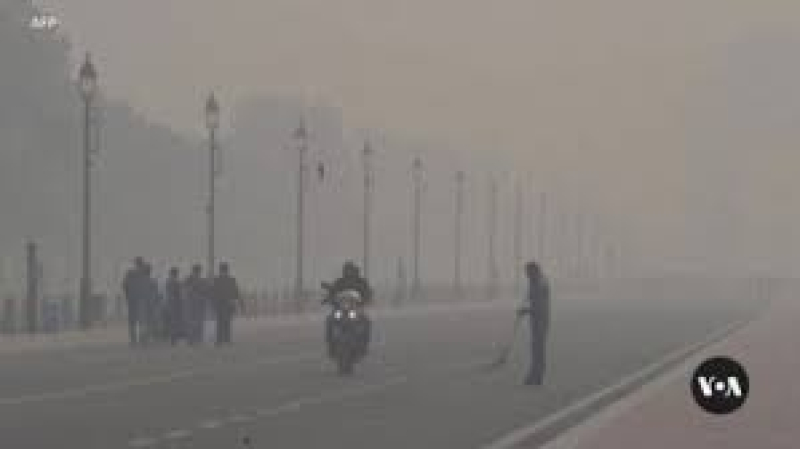- CA Yunus pays homage to Liberation War martyrs on Victory Day |
- Bangladesh capital market extends losing streak for second day |
- Bangladesh celebrates Victory Day Tuesday |
- 'Different govts presented history based on their own ideologies': JU VC |
Delhi's Deadly Air Pollution Prompts Some to Quit City

Prashant Kalra relocated to the western coastal city Goa five years ago because the dirty air in the Indian capital and surrounding towns was making his three-year-old daughter sick.
“Our daughter could not breathe in Delhi-NCR,” said Kalra, who lived in Gurugram, a city adjacent to New Delhi. “She needed a nebulizer every night just to go to sleep. That convinced us that we did not have a choice.”
The NCR, or the National Capital region is a vast, urban sprawl that refers to the Indian capital and its surrounding areas.
Kalra is among a small but growing number of people quitting the city to escape the health hazards of the deadly air pollution that envelops it every winter. A nearly two-decade long battle by authorities in Delhi has failed to clean up the toxic smog, which is a mix of construction dust, vehicular emissions and burning of crop residue in neighboring agrarian states.
Many of the “pollution migrants” as they are being called, are heading to Goa, a popular holiday destination with long beaches and palm trees, that has become a magnet for people fleeing Delhi’s air.
Like Kalra, many moved after their children developed health problems. For Salil Pawah and his wife, the trigger was their young daughter’s persistent cough.
“She got put on a nebulizer and an inhaler in Delhi,” said Pawah, an entrepreneur who had always lived in the Indian capital. “We came here for a short vacation for a few weeks and that cough all but vanished. That is when I realized that it is the air and we kind of decided that we have to leave Delhi.”
Delhi is regularly ranked as one of the world’s most polluted cities, with its annual smog blamed for thousands of premature deaths each year.
The average city resident could die nearly 12 years earlier than expected because of air pollution, according to a report last August by the University of Chicago's Energy Policy Institute.
In New Delhi, doctors say every winter brings an influx of patients suffering from respiratory problems or worse – this winter was no different.
“Basically, it is asthma, bronchitis, infections that was the most common disease that we faced this time,” according to Suranjit Chatterjee, a doctor at New Delhi’s Indraprastha Apollo Hospital. “We also have a few strokes and cardiovascular diseases, which are well known to be exacerbated by the pollution.”
The deadly ingredient in Delhi’s air is small, particulate matter called PM 2.5, which gets embedded deep inside lungs. Chatterjee says children and older people bear the brunt of the smog.
On the most polluted days, authorities order schools to shut and advise people to stay indoors. The city’s air quality index often reaches hazardous levels of over 400.
Uprooting from a city that was home is not easy. And while Goa’s lush greenery and laid-back vibe are a great pull for holidaymakers, settling in the city came with challenges.
“It was difficult leaving friends behind, but luckily most of our family moved with us, my father and elder sister. Of course, socially and culturally, it was an adjustment,” said Kalra, who calls himself a “pollution refugee” on his Instagram account.
But Kalra, who was formerly a lawyer, saw opportunity in the steady stream seeking refuge from Delhi’s grey skies. He started a brokerage firm to help people find new homes in Goa and managed to sell four early on.
“That gave us the confidence to make the switch and start building our social media and working on the business and five years on we are quite happy where we are,” he said. And the family has adapted to life in Goa. “Being a little bit closer to nature, having a fish curry on the beach on Sunday, it's good here."
The numbers heading to Goa from Delhi have accelerated since the COVID-19 pandemic, when work from home norms gave employees the flexibility to work from different locations.
“When I moved to Goa, I did not know anybody else. Now in a span of two years, I know probably 20 people who moved here for the same reason,” said Pawah. “COVID taught us that it’s not the city itself that is important, it is the work you do. Now you will see a lot of professionals here, lawyers, engineers, doctors.”
Moving out of Delhi is a choice available only to a few. Many of the 30 million residents in the city and adjacent districts work on the streets – as auto rickshaw drivers, street vendors and construction laborers suffering the worst exposure. Doctors say the toxic air is a serious health hazard.
“The pollution is a major health issue. Now the duration of the pollution has also lengthened and exposure long-term to high pollutants obviously affects everybody’s health,” according to Chatterjee.
Cleaning up India’s mega cities will be one of the country’s biggest challenges as Prime Minister Narendra Modi, who is widely expected to win a third term in office in elections early this year, sets an ambitious goal of catapulting India into the ranks of developed nations by 2047.

